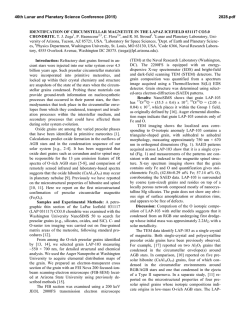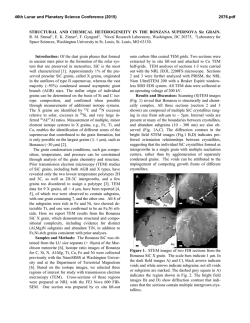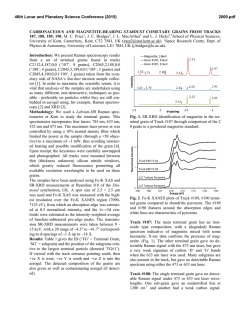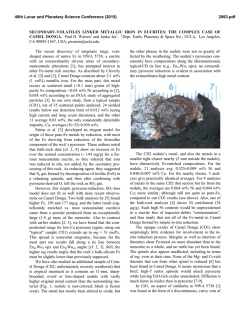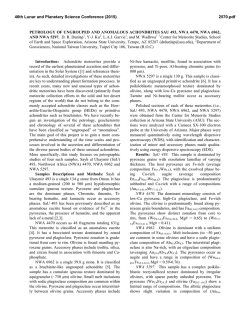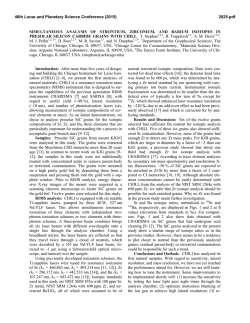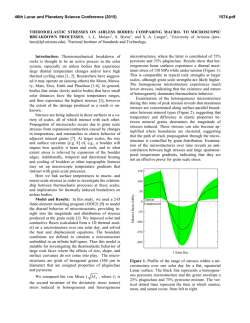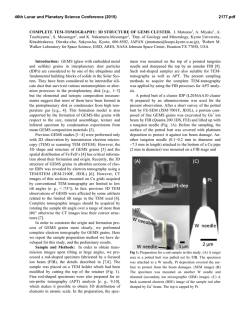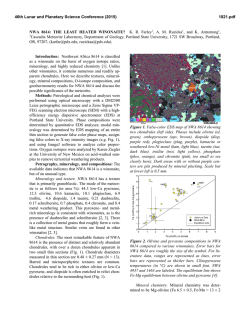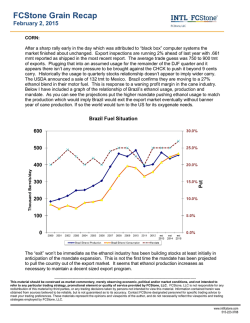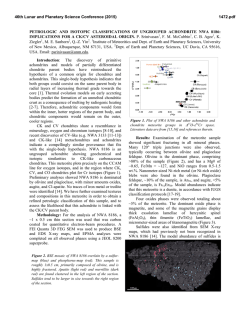
A TEM STUDY OF THE FINE-GRAINED MATERIAL OF THE NWA
46th Lunar and Planetary Science Conference (2015) 1832.pdf A TEM STUDY OF THE FINE-GRAINED MATERIAL OF THE NWA 7533 MARTIAN REGOLITH BRECCIA. H. Leroux1, M. Marinova2, D. Jacob1, R. H. Hewins3, B. Zanda3, M. Humayun4, J. P. Lorand5. 1Unité Matériaux et Transformations, University of Lille & CNRS, F-59655 Villeneuve d’Ascq, France, [email protected]. 2 Institut Chevreul, University of Lille & CNRS, F-59655 Villeneuve d’Ascq, France. 3 IMPMC, Sorbonne Université, Muséum National d’Histoire Naturelle, UPMC Université Paris 06, 61 rue Buffon, F-75005 Paris, France. 4Florida State University, Tallahassee, FL 32310, USA. 5Laboratoire de Planétologie et Géodynamique, Université de Nantes, F-44322 Nantes, France Introduction: NWA 7533 (and paired meteorites) is a Martian regolith breccia [1-3]. It contains a suite of coarse-grained igneous clasts cemented by an abundant fine-grained interclast crystalline matrix. The matrix material is dominated by low-Ca pyroxene and plagioclase feldspar for which the compositions are close to that of the coarse grained fraction of the rock [1]. Feoxides grains (magnetite and maghemite) are also abundant but comprising <20 wt. % to a lesser extent. Water-rich phases were also identified in this finegrained matrix. They include hydrous Fe oxide phases, phyllosilicates (saponite) and Cl-rich apatite [4]. The Fe oxides and Fe-hydroxide phases reveal that the breccia could have been affected by secondary processes involving water on Mars [1,4]. In this study, we investigated by analytical transmission electron microscopy (ATEM) the chemistry and the microstructure of the fine-grained matrix of NWA 7533 in order to better characterize the mineral assemblage and to gain information on formation mechanism(s). Methods: A section of NWA 7533 was first studied by scanning electron microscopy (SEM). Three fine-grained matrix areas were selected for the extraction of electron transparent sections (~100 nm thick) by the focused ion beam (FIB) technique. The FIB work was done using a FEI Strata DB 235 at IEMN at the University of Lille, France. The FIB sections were studied by TEM with a FEI Tecnai G2-20 Twin (LaB6, 200 kV) and a Philips CM30 (LaB6, 300 kV) at the electron microscopy center of the University of Lille, France. Both instruments are equipped with an energy dispersive spectrometer (EDS) for elemental microanalysis. Results: The three FIB samples studied have comparable microstructure, suggesting that the fine-grained matrix is fairly homogeneous in the rock. Figure 1 shows a scanning TEM low magnification view of the fine-grained material. The assemblage is strongly dominated by low-Ca pyroxene and feldspar grains. The average grain size is close to 300 nm. The shape of the grains is irregular but the grains are well interspersed with each other. As mentioned earlier for the NWA 7034 paired meteorite [4], frequent triple junctions are present. Compositions of the low-Ca pyroxenes range from En64 to En74. These pyroxene grains contain a high density of planar defects on (100) corresponding to thin alternating domains of clino- and orthopyroxene. Most of the feldspar grains are plagioclase (from An14 to An57) with minor alkali feldspar. Three large (> 1 µm) grains of Cl-rich apatite have been identified. Apatite grains contain crystal defects, mostly dislocations organized along regular subgrain boundaries or deformation bands. Fe-oxides, for which the electron diffraction patterns are compatible with magnetite, are distributed throughout the matrix. The grain size ranges from 1 µm to a few nm. When small, Feoxides are preferentially located in the pyroxenefeldspar grain boundaries but are also present within the pyroxene grain interiors. In this latter case, they have a significantly lower size compared to the grains within the grain boundaries. Figure 1: Low magnification dark-field STEM image of the fine-grained matrix of NWA 7533. The dark gray areas correspond to feldspars. The medium gray corresponds to low-Ca pyroxene. The bright grains are Fe-oxides. One of the most remarkable characteristic of the fine-grained matrix is the thickness of the grain boundaries. Most of the grain boundaries are thick (typically 46th Lunar and Planetary Science Conference (2015) 10 to 20 nm) and filled with a low density amorphous material (Fig. 2 & 3). Intergranular porosity is also abundant, in particular at triple junctions. At high magnification, the intergranular material has a spongy appearance and frequently contains small bubbles. This material is very sensitive to the electron beam and its appearance may change during the observation, from spongy to smooth appearances. So far, we did not identify phyllosilicates, as reported earlier in NWA 7034 [4-5]. Figure 2: TEM bright-field image showing the thick grain boundaries, filled by a low density material. Note also that the porosity is preferentially located at triple junctions (brighter areas). Figure 3: High magnification bright field TEM image showing the interstitial amorphous material in a grain boundary. The chemical analysis of grain boundaries is difficult because of their low density and thickness (compared to that of the FIB samples, about 100 nm). Chemical maps and profiles across grain boundaries revealed a variable chemistry, depending on the grain boundary studied. In some cases this intergranular ma- 1832.pdf terial seems to have the same composition as that of the adjacent grains, but for a number of other grain boundaries we detected a clear and significant enrichment in SiO2 (typically from 55 wt.% in pyroxene to 70 wt.% in grain boundaries). Some of the boundary materials are rich in Cl and Ca. Discussion and conclusion: The matrix of NWA 7533 is a sub-µm granoblastic assemblage composed of grains whose compositions are related to the larger clasts. This mineral assemblage is partially sintered. Although some well equilibrated triple junctions are observed, most grains have preserved an irregular morphology and porosity at triple junctions. This texture suggests a moderate annealing intensity, corresponding to a brief heating event or during a longer time at relatively low temperatures, as already reported earlier [5]. The vast majority of the grain boundaries are destabilized, as evidenced by their substantial thicknesses and the presence of a low density amorphous material having variable compositions. A possible explanation may be advanced in light of the pyroxene decomposition into silica and Fe-oxide identified in coarse pyroxene clasts [6]. This reaction could also have concerned the small pyroxene grains of the matrix and could have led to the formation of Fe-oxides and silica enrichment of the grain boundaries. To occur, this reaction requires a high temperature and a high oxygen fugacity, at least 23 log unit above FMQ [7], consistent with a water-rich environment. Another plausible explanation concerns modifications which probably occurred during the prolonged stay of NWA 7533 and its paired meteorites in hot desert conditions. During this period, the rocks were exposed to alteration at low water/rock conditions, during which pyrite was partly replaced by Feoxyhydroxides [8], leading to highly acidic conditions which could have enhanced the grain boundary alteration of the fine-grained matrix. References: [1] Agee C. B et al.. (2013) ScienceExpress DOI: 10.1126/science.1228858. [2] Humayun M. et al. (2013) Nature 503, 513-517. [3] Hewins R. H. et al. (2013) LPS XXXIII, Abstract #2385. [4] Muttik et al. (2014) Geophys. Res. Lett. 41, doi:10.1002/2014GL062533. [5] Muttik N. et al. (2014) LPS XLV, Abstract #2763 [6] Leroux H. et al. (2015) LPS XLVI, Abstract, this conference. [7] Frost B. R. and Lindsley D. H. (1991) Rev. Mineral., 25, 433-468. [8] Lorand J. P. et al. (2014) 77th Annual Meteoritical Society Meeting, Abstract #5123. Acknowledgements: The authors thank D. Troadec for the preparation of the samples by FIB.
© Copyright 2026
